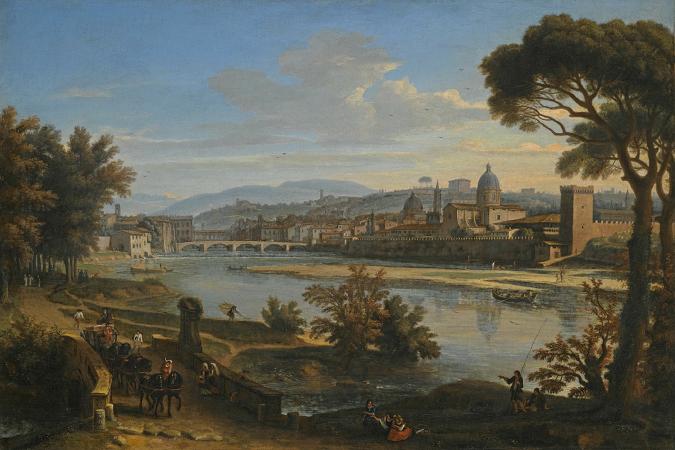Parco delle Cascine (1563). The Parco delle Cascine is a monumental and historical park in the city of Florence. The park covers an area of 160 hectares. It has the shape of a long and narrow stripe, on the north bank of the Arno river. It extends from the centre of Florence until the point where the Mugnone flows into the Arno. The building of the Park began in 1563, under the rule of Cosimo I de' Medici, as a farming and hunting estate of the Medici family, ruling the city of Florence since 1434. The very name of the Park derives from the ancient Italian word cascio, meaning bovine livestock, mainly intended for the production of butter and cheese. Since the beginnings of its building, the maintenance of the park was particularly well cared by the Medicis. Rare and exotic plants were chosen for the park, also for scientific reasons. With the end of rule of the Medici in favour of the Habsburg-Lorraines, the park acquired a recreative function in the urban system, conserved until the present days. However, until the beginning of the 19th century, the park remained usually closed to the public, with the exception of some particular recurrence. At the end of the 18th century the park was enriched with buildings by the architect Giuseppe Manetti, such as the Palazzina Reale, the Abbeveratoio del Quercione fountain, the pyramid-shaped ice house, the amphitheatre and the nautical plant of the Pavoniere. The two neoclassical Pavoniere were originally built as ornamental peacock cages. A number of fountains were built at the time, perhaps the most famous is the Narcisus Fountain, from which the English poet Percy Bysshe Shelley draw inspiration writing the Ode to the West Wind, in 1820. Giuseppe Manetti was also responsible for organising celebrations and receptions in the park, such as the celebration for the assignment of Ferdinand III of Tuscany, in July 1791. The Grand Duchy Pietro Leopoldo ordered the construction of a model farming estate, around the Palazzina Reale building. The park became public at the beginning of the 19th century with Elisa Baciocchi, which fostered a number of preservative interventions. The park was acquired by the Municipality of Florence in 1869, which committed the renovation of the park to the architect Felice Francolini. Sport clubs which regularly competed in the Quercione meadow were: Florence Football Club, Itala Foot Ball Club, Juventus Foot-Ball Club, Firenze FBC, Club Sportivo Firenze and PGF Libertas. However, in 1917 the municipality decided to forbid to any sport club to play football in the park. The last relevant monument built in the Cascine Park was the Monumento all'Indiano a monument realised by the English sculptor Fuller in honour of the young Indian prince His Highness Rajaram II, Maharaja of Kolhapur, who suddenly died while visiting Florence in 1865. The amphitheatre was named in March 2015 after a well-known son of Florence, Ernesto de Pascale, music journalist and bluesrock musician who died 2011. A number of meadows of different extension, sometimes limited by wooded areas, are situated in the park: their names are Tinaia, del Quercione, delle Cornacchie. Other smaller meadows are situated within gardens or squares. Wooded areas cover more than 35 hectares. The total number of trees situated in the park is about 19.000. The secular human presence radically modified flora, reducing its natural self-renovation. Centuries-old English oaks, elms, maples and ashes are slowly being replaced by spontaneous vegetation, represented by acacias, trees of heaven, elders, ivy, pines and nettle trees. The highest level of species assortment can be found in the western part of the park, while in the eastern part, nearer to the city centre, mainly lindens and oaks are diffused. A botanically relevant arboretum is situated in the garden of the Scuola di Guerra Aerea. The strength and luxuriance of plants show the fecundity of soil and the presence of a good water reserve, communicating with the Arno bed. Long hedges, selected to resist to dryness and to shady positions, are present everywhere in the park. The central part of the park is characterised by a monumental complex, situated in Piazzale delle Cascine, dominated by the Palazzina Reale, and its bordering areas, including Piazzale Kennedy with its circular fountain. The Piazza Vittorio Veneto, with the Vittorio Emanuele II bronze statue, represents the monumental entrance of the park. The statue was once situated in the centre of Florence, Piazza della Repubblica, and was moved in the actual position in 1932. The square, along with the bordering Giardino della Catena, is decorated with impressive trees. This variety of species gives to the area the autumn colourfulness typical of Italian style gardens.
more...




